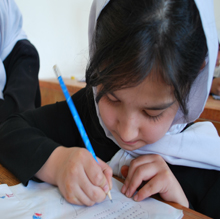The events of August 15, 2021 triggered a sharp contraction and reconfiguration of the Afghan economy and approaches to international aid. Reduced aid drove a steep decline in aggregate demand and widespread disruptions to public services. Afghanistan lost access to the international banking system and offshore foreign exchange reserves as the central bank assets were frozen. Disruption and uncertainty led to sharp declines in investment confidence, and tens of thousands of highly skilled Afghans fled the country.
After a severe 20.7 percent GDP contraction in 2021, the Afghan economy contracted further by 6.2 percent in 2022. While Afghanistan’s agricultural and subsistence economy, including illicit opium production, provided some resilience in rural areas, higher prices, reduced demand, lower employment, and disruptions to services had severe impacts across the country. The proportion of households that did not have enough income to meet basic food needs more than doubled from 16 percent to 36 percent in this period.
In the context of deep concerns about the policies of the interim Taliban administration (ITA), including restrictions imposed on women and girls, the international community, including the World Bank, recalibrated its approach to supporting Afghanistan: first to providing humanitarian support and then to providing off-budget support for basic service delivery and livelihoods.
The rapid deterioration of economic conditions slowed by the summer of 2022. This can be attributed to the end of active conflict and the resumption of international humanitarian and basic service aid beginning in December 2021. The off-budget aid helped some recovery in private sector activity by cushioning falling aggregate demand amid relative political stability and reduced corruption. The interim Taliban administration (ITA) moved to restore domestic revenues, which reached $2.2 billion or 15 percent of GDP in 2022, although still lower than the on-budget $5.2 billion available during 2019. Nevertheless, overall economic activity remained depressed, unemployment stayed high, and the banking sector was dysfunctional due to constraints on international transfers and concerns about liquidity and solvency.
Today, Afghanistan's economic outlook remains uncertain, with the threat of stagnation looming large until at least 2025. The absence of GDP growth coupled with declining external financing avenues for off-budget expenditures paint a bleak picture of the country's economic prospects. Structural deficiencies in the private sector, coupled with waning international support for essential services, are expected to impede any appreciable economic progress. This economic stagnation will deepen poverty and unemployment, with job opportunities expected to decrease and food insecurity expected to increase.
Afghanistan's long-term growth prospects rely on a significant shift from reliance on international aid and consumption-driven growth to a more resilient, private sector-led economy that capitalizes on the country's inherent strengths. For a sustainable future, Afghanistan needs to focus on its comparative advantages, particularly in the agricultural and extractive sectors. Agriculture could be a key driver of growth and poverty reduction, with the potential to create jobs. To realize this potential, strategic investments are needed in irrigation infrastructure, land tenure security, research, and market access to enhance agricultural productivity and resilience. These efforts should be supported by investments to strengthen human capital and create the institutional frameworks needed for a conducive business environment.
Last Updated: Apr 18, 2024


